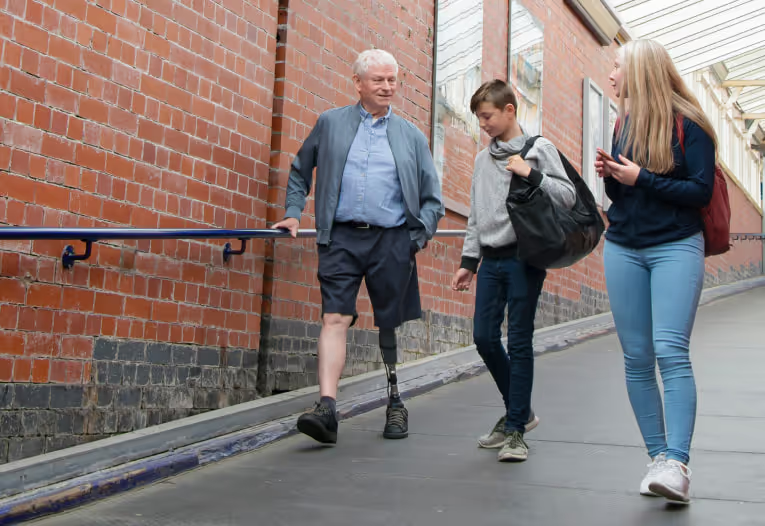Ground Reaction Ankle Foot Orthosis (GRAFO), New Mexico
Boost your mobility with a custom Ground Reaction AFO from PrimeCare in Las Cruces! Regain stability and take confident steps forward. Visit us today!

What Is a GRAFO Orthosis?
Ground Reaction Ankle Foot Orthoses are specialized devices designed to enhance stability and mobility for individuals experiencing quadriceps or plantar flexor weakness. By strategically positioning the ground reaction force in front of the knee joint, GRAFOs prevent the knee from collapsing and promote proper limb alignment during walking. This helps distribute weight and impact effectively, ultimately reducing the risk of knee hyperextension and improving overall gait.

At PrimeCare, our clinics provide comprehensive assessments, fittings, and ongoing support to ensure that each GRAFO is tailored to the unique needs of the patient. We’re proud to help them achieve greater confidence and independence in their movement.
How Ground Reaction AFOs Work

The GRAFO is a solid orthosis that acts as a strut between the ankle and knee, leveraging the large tibia to improve knee control during the stance phase of walking. Directing the ground reaction force to create an extension moment at the knee, it helps prevent knee collapse or flexion.

By maintaining the ankle joint at approximately 90 degrees to the tibia and preventing excessive dorsiflexion, the GRAFO counters knee flexion and allows for smooth rollover during walking. As the step completes, the ground reaction force shifts anteriorly along the foot, resulting in controlled knee flexion for a natural gait.

During the swing phase, the GRAFO maintains the ankle at 90 degrees, helping with foot clearance.
Get Back on Your Feet!
Book your appointment with PrimeCare now and experience the benefits of a GRAFO for improved mobility and support!

Conditions That May Benefit from a GRAFO
A Floor Reaction AFO is often recommended for patients experiencing mild to moderate knee instability. This instability is typically due to a combination of quadriceps weakness, reduced plantar flexion strength, and conditions such as excessive ankle dorsiflexion, crouch gait, or foot drop, which impact their ability to effectively push off the ground during walking.
We usually prescribe GRAFOs for individuals managing physical or neurological conditions, including but not limited to muscle weakness and the associated gait impairments.
Motor Neuron Disease
Multiple Sclerosis
Hemiplegia
Guillain-Barré Syndrome

GRAFO Assessment and Custom Fitting Process

- Step 1: Comprehensive Assessment
The first step is a thorough evaluation by one of our experienced Orthotists. This assessment ensures that a Ground Reaction Ankle-Foot Orthosis is the most suitable solution for the patient’s needs. During this appointment, we evaluate the patient’s gait pattern, stability, and muscle strength to ensure that a GRAFO is the ideal choice before moving forward with the customization process.
- Step 2: Trial with In-House Devices
To determine if a GRAFO is beneficial, we offer trial fittings with our in-house devices. This allows patients to experience the support and function of a floor reaction ankle-foot orthosis before committing to a custom-made option. If the trial is effective in improving knee extension and controlling ankle position, we proceed with the next steps to make the device personalized.
- Step 3: Custom Casting and Design
Once we have confirmed that a GRAFO is ideal, we take a precise cast of the patient’s leg using plaster during the initial consultation. This cast serves as the foundation for creating a custom-fitted orthosis. We modify the cast to accurately reflect the patient's unique leg shape and anatomical needs.
- Step 4: Fabrication and Handcrafting
With the modified cast, our skilled technicians start the process of handcrafting the GRAFO. Each brace is made manually, with careful attention to detail. We select and position the straps, padding, materials, and trim lines to ensure the orthosis fits comfortably and functions optimally according to the patient’s requirements.
- Step 5: Final Fitting and Adjustments
Once the GRAFO is completed, we conduct a final fitting session to fine-tune the orthosis. We ensure that the device provides the necessary support and comfort, enhancing stability and correcting the gait pattern by optimizing the interaction between the footplate and ground reaction force. Our goal is to deliver a high-quality, custom-fitted orthosis that improves both the mobility and the quality of life for the patient.
Why Choose PrimeCare for Ground Reaction Ankle-Foot Orthosis?

Personalized Support

Cutting-Edge Technology

Experienced and Compassionate Team
Patient Success Stories









Insurance and Financing
We understand that navigating insurance and financing can be overwhelming. That’s why we provide estimated service costs upfront, giving you financial clarity before you begin treatment. Our goal is to help you focus on your health and recovery without the added stress of financial uncertainty.
Contact Your Local GRAFO Provider in New Mexico
Based in Las Cruces, PrimeCare proudly serves patients from surrounding areas, including Ciudad Juarez, El Paso, Albuquerque, and beyond. Our team is dedicated to providing high-quality, personalized care to help you achieve greater mobility and independence.
Mon-Fri: 9:00am-5:00pm
Sat-Sun: Closed

.svg)
.svg)


